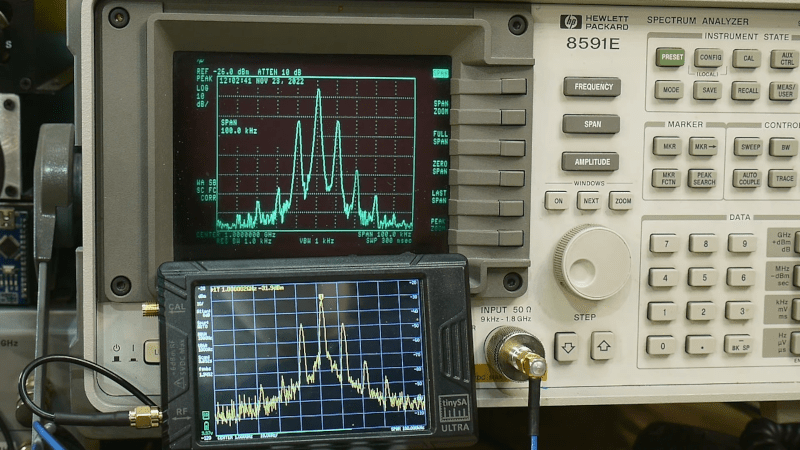We’ve looked at the TinySA spectrum analyzer in the past. However, the recent Ultra edition offers an increase in range from 800 MHz to 6 GHz. How does it work? [IMSAI Guy] tells us in a recent video that you can watch below. In addition to an increased frequency range, the new device offers a larger display and enhancements to the signal generator and bandpass filtering. It also has an optional LNA. All this, of course, is at a price since the Ultra sells at a little more than twice the original unit’s price. Still, $120 or so for a 6 GHz spectrum analyzer isn’t bad.
For some reason, you have to put a passcode in to enable the Ultra mode, although the passcode appears to be common knowledge and available on the device’s wiki. You can presume they could, at some point, make this feature or others require a paid passcode, but for now, it is just a minor inconvenience. Reminds us of a certain oscilloscope that’s become quite popular in our community.
One thing you should be aware of, however, is that the Ultra mode uses a mixer to downconvert the incoming signal to the ordinary 800 MHz range. That means, as you can see in the video, that the local oscillator puts out some signal at the input. The level is relatively low, but still something to be aware of if you are trying to make a precision measurement.
The video compares the device to an HP 8591E spectrum analyzer. It tops out at 1.8 GHz and runs about $2,500 new. Even on eBay, you can expect to pay between $500 and $1000 for one of these. The results seem to be comparable, for the most part.
We looked at the device’s predecessor back in 2020. We also did a full-blown review a little bit later.

















Interesting, after watching the video, I wonder if I would be better off buying the HP unit instead.
The only reason for asking the unlock code is to have people read the wiki page describing the limitations of the Ultra mode.
As the source code of the tinySA is GPL v3 the unlock code will always be visible in the source.
The leakage as mentioned by IMSAY Guy is below -10dBm so not a big danger to other equipment.
Second hand SA’s, especially those that use harmonic mixing, have similar leakage.
say the secret word and the duck flies down and give you an extra gigahertz.
come on. you missed the headline by *that* much.
You’re dating yourself (ok, us). I don’t think most people today would recognize a reference to “You Bet Your Life” (ollllllddddd TV game show hosted by Groucho Marx. [crickets] Groucho. Marx. The Marx Brothers. You don’t get down from an elephant, you get down from a duck. No relation to Karl.)
What’s the secret word?
Swordfish
I got a nanoVNA to get the larger screen. Now I’m tempted to upgrade my TinySA.
Harder to justify, because I never look above 800MHz.
Can someone please explain what a spectrum analyser does which an SDR can’t already do?
Give you calibrated, repeatable measurements.
Most consumer SDR’s are unusable for measuring the harmonic output of some transmitter.
You will see them, but will be left guessing what their actual amplitude is and if they are real or generated by the SDR overloading.
I’d argue that some or many are buying because they are cheap, and use them like they’d use a wide coverage receiver, to find signals. Nobody asks about dynamic range, or close in specs.
“buying because they are cheap”
Darn strait!! I had dreamed of having a SA for over 40 years.
Had one at work, but it DID NOT leave the shop.
Is the TinySA the same quality as a HP or even a Siglint ?? NO.
But for $130.00 it is simply incredible. Even 10 years ago a hobbyist
could not imagine this gear. Although I now have a
Siglent SSA3021, I still bought this little guy and it compares well.
AND–Is a lot more portable!
New price of the 8591E was used to be between, 11000 and 18000 dollars dependent what options. Base price was ~11k. I todays money, adjusted for inflation that base price would be around 30k+ for a 1993 production.
Kinda cool but a shame the hw isn’t open. They even bitch about inferior clones on their website — open the hw and the clones will be better!
Ask Rohde and or Agilent to make their hardware open source and they will laugh you out of the room. Why would any business give away their trade just so those that are too cheap can buy good clones? At ~$140 the profit margin is already very slim, why would any manufacturer willingly cut into that?